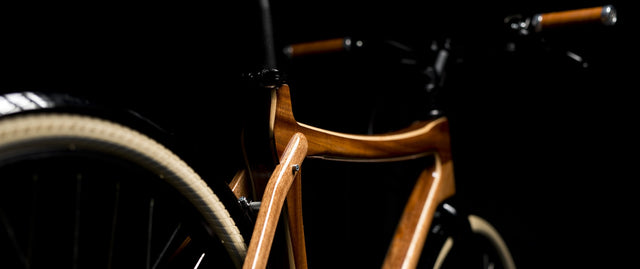Why wood

WOODEN BIKES
Do they break easily?
Can they withstand rain?
Can they be compared to regular bikes?
– Questions similar to these are completely logical and expected since wooden bikes aren't too common. We have had the same questions and concerns ourselves and have tried our best to answer them. Not so long ago we even left one of our bike frames chained to a fence from autumn to spring (with temperature dropping down to -15°C/5°F) and there was no visible damage to the frame (in fact the frame is being used now), but since that is not a very scientific approach, we have been to EFBE Prüftechnik testing labs to get official tests done and measurements taken on our frames. We have the certificates.
Short answer – they don't break easily, they can withstand much more than rain and they can be compared to regular bikes – they even are superior in some aspects (like smoothness of riding).
Here are the results and conclusions. In fact, we are so confident about these results, that a 5 year warranty is given on all frames sold.
WOODEN BIKES STEAL HEARTS
This is the reason that matters to us the most. This is why we make them. This is what puts sparks in peoples eyes. We ride these bikes ourselves and we see this first hand. Just look at it:

PREMIUM RIDE QUALITY
- Wood absorbs four times as much vibration as carbon without gimmicks or reinforcement.
- More than any other frame material - the entire Materia Bikes frame is a superior vibration damper, not through flex, but within the material.
- Wood can deliver the ideal balance of stiffness and smoothness suiting the type of bike
- Materia Bikes frames are hollow and lightweight, but damage resistant and tolerant, providing the best balance of durability and performance for the enthusiast rider.
EXACTLY WHY DO MATERIA BIKES FRAMES HAVE THE SMOOTHEST RIDE?
The three major reasons are shown in the table. The best materials for damping vibration have low density and low stiffness. When coupled with the low vibration transfer speed, these properties determine how well a material damps vibration. Wood has by far the lowest of these properties and we further enhance ride quality with extensive engineering.
| MATERIAL | DENSITY OR WEIGHT, G/CM3 | STIFFNESS, GPA | VIBRATION TRANSFER SPEED, M/SEC | RIDE QUALITY |
FRAME MFG. COST
|
| Steel | 7.8 | 200 | 5000 | Smooth | Medium |
| Titanium | 4.5 | 110 | 6000 | Smoother | Medium High |
| Aluminum | 2.7 | 69 | 5300 | Harshest | Lowest |
| CFRP | 1.6 | 56 | 15000 | Harsh | Medium |
| Walnut | 0.6 | 12 | 3600 | Smoothest | Highest |
| Ash | 0.6 | 12 | 3600 | Smoothest | Highest |
| Redwood | 0.4 | 9 | 3600 | Smoothest | Highest |
COMPARING VIBRATION DAMPING – WOOD VS. OTHER MATERIALS
Due to the cellular makeup of wood it has much higher vibration damping than other frame materials. Note that wood absorbs vibration within the material, not through flexing. Wood and all other frames flex, but that property belongs in a discussion about stiffness.
Unlike metals and carbon which transmit shock and vibration, wood absorbs it. So unlike some frame manufacturers who use gimmicks in their carbon frames to tame the harsh ride, Materia Bikes has used what we call Full Frame Vibration and Shock Damping (FFVSD) for the past five years, where the entire frame is engineered as a shock absorber using the superior vibration damping of wood, further engineered to minimize vibration. Materia Bikes frames deliver the smoothest ride of any frame with comparable stiffness, and are renowned worldwide for their unequaled ride quality.

HISTORY OF WOODEN BICYCLES AND PRODUCTION
The use of wood technology in bicycle construction dates back to 1817 and the invention of the bicycle by Baron Karl von Drais. His “Draisine” was built with the best technology of the time; frame and wheels held together with nails and pegs. Since then, wooden bikes were manufactured off and on worldwide through the late 1940's, but virtually none have been hollow nor were they engineered for performance.
Modern technology was introduced to wooden bicycle frames by Renovo in 2007, 190 years after the first wooden bike. Nowadays, the majority of wooden bicycle producers are using computer controlled (CNC) router to precisely mill the frames in hollow halves, which are later bonded together. With state-of-the-art adhesives, finishes and manufacturing techniques we have produced high performance, lightweight wood bicycles so durable and beautiful they have become treasured heirlooms.
It takes many steps to make our frames, and at each one we take steps to ensure quality.
THE RIGHT BOARDS
The appearance of each bike is unique because grain, color and figure vary, even within the same board. We spend ridiculous amounts of time at four different specialty lumber yards choosing the perfect lumber, and more time back at the shop deciding how to cut and match the 16 to 40 pieces of wood in a frame. But we confess we love going to the lumber yard, it's an exciting treasure hunt every time. It’s way more fun than just ordering another steel tube set or sheet of carbon fiber.

PLANKING AND MILLING
Once we’ve selected our lumber, it must be cut to precise dimensions for our laminating process, whereby we join together multiple layers of wood into a single plank to achieve the desired stiffness, weight and aesthetics. These laminate planks then make one or more trips to the CNC router as we mill frame parts, bond them together and mill them again and seal hollow structures before joining the frame sub-assemblies into a complete frame. Each frame component’s trip to the CNC represents hours of time spent by our engineers planning the sizing, wall thicknesses and production methods.
BONDING
We use two different epoxy formulations to meet our requirements of withstanding high temperatures, resisting moisture and bonding complex joinery. All hollow frame components are sealed inside prior to bonding. We have bikes that endure extreme weather in Norway, Rusia, Brazil, Singapore, Dubai and Australia with never a failure from these changing conditions. To ensure consistent and good bond quality, we follow industry standard practice: meticulous surface preparation, good process control and good training—pretty much the same set of criteria to ensure good bonds on carbon bikes or good welds on metal bikes. All bonding is done in a climate-controlled room and the frames are oven cured to achieve the highest possible bond strength.
METAL
We use metal for sleeves in the head tube, upper seat tube and bottom bracket, as well as our house-designed dropouts. These alloy fittings allow us to use industry-standard parts. All bonded aluminum is abrasive blasted, acid etched and alodined for maximum bonding strength

SHAPING
Our CNC mill does the heavy lifting, making the rough shapes of our frames from straight pieces of lumber. That said, the beauty of our frames is made possible by our craftspeople, who painstakingly blend the sharp edges cut by machine into the flowing lines that mark our frames as unmistakably hand-finished. Every frame is hand-sanded for hours, smoothing and refining machine work into the flowing lines envisioned by our designers.
FINISHING
Our finish coating is a multi-layer affair, with separate sealers and waterproof polyurethane formulated for outdoor use on wooden structures. We have found it to be the toughest, most waterproof clear coat available. No other coating compares to our finish for blocking Ultraviolet damage and moisture.
SURVIVING REAL-WORLD CONDITIONS
In a properly designed structure, properly sealed and bonded, wood is unaffected by hot, wet or cold outdoor environments; modern wooden boats live in the water, wooden aircraft and wooden propellers fly through it.
• Moisture content- Wood “seeks” moisture equilibrium with its environment, so its content varies by season, ranging from about 8% to 14%, which has no structural or cosmetic consequence to the frame. The finish on the outside and sealer on the inside minimize the change.
• Dimensional change- Moisture causes expansion/contraction of the wood across the grain, but only in proportion to its thickness, so for the majority of the Materia Bikes frame, the change is only a few thousandths of an mm over a 6 month period, a non-issue. There is negligible dimensional change lengthwise with the grain.
• Heat/cold effects- Wood gains strength as it gets colder, and loses strength with heat, but the Materia Bikes frame is designed for temperatures in the range of human activity, so heat or cold has no material effect.
• Warping, Cracks- These problems occur in wood from improper drying before machining, or for example in the case of the twisted studs in the walls, using non-kiln dried wood. Look at fine quality furniture hundreds of years old, you won’t find cracks. All wood used in the Materia Bikes is kiln-dried before we buy it, but we check and adjust the moisture content to make sure it’s in the correct range if necessary.
MAINTENANCE
No more is required than any other painted bike, perhaps less. A scratch through the paint and sealer could be a cosmetic problem if left unsealed, much like a steel frame—if the scratch got wet enough, often enough, the finish around the scratch might eventually blister. A quick fix is clear nail polish, although a more complete repair is simple and unlikely to require a pro.
VR production video
SUPERIOR DURABILITY AND TESTING
Here at Materia Bikes we take our work seriously. Safety and comfort is our mantra. We want you to feel safe when driving our wooden bikes thus every bike we make is tested both in computer simulations and in a certified laboratory – the EFBE Prüftechnik
FATIQUE TEST FRAME WITH PEDALING FORCES
Fatigue test frame with pedalling forces ISO 4210, city/trekking bikes. (RDWISO-S)
Test load: +1025 N
Allocated number of loads: 100 000
Test result: The allocated number of loads was reached without any crack or fracture.
The test was passed.
FATIQUE TEST FRAME WITH VERTICAL FORCES
Fatigue test frame with vertical forces ISO 4210, city/trekking bikes. (RDFSISO-S)
Test load: +1025 N
Allocated number of loads: 50 000
Test result: The allocated number of loads was reached without any crack or fracture.
The test was passed.
FATIQUE TEST FRAME WITH HORIZONTAL FORCES
Fatigue test frame with horizontal forces ISO 4210, city/trekking bikes. (RDGISO-S)
Top load (against direction of travel): +461N
Bottom load (into direction of travel): +461N
Allocated number of loads: 100 000
Test result: The allocated number of loads was reached without any crack or fracture.
The test was passed.
Impact test frame/fork falling mass and falling frame
Impact test frame/fork falling mass ISO 4210, city/trekking bikes. (RGIFMISO-S)
Weight 22,5 kg,
Drop height 180 mm.
Test result: Permanent deformation: 5mm, Crack or fracture: No
The Impact test was passed.
Impact test frame/fork falling frame ISO 4210, city/trekking bikes. (RGIFRISO-S)
Weight 90 kg overall
Drop height 200 mm.
No crack or fracture or displacement more than 60 mm.
Test result: Permanent deformation: 4mm, Crack or fracture: No
The Impact test was passed.
SUMMARY
Materia Bikes offers a premium ride quality with their wood frame, which absorbs four times more vibration than carbon. These hollow and lightweight frames deliver an ideal balance of stiffness, smoothness, durability, and performance for the enthusiastic rider.


